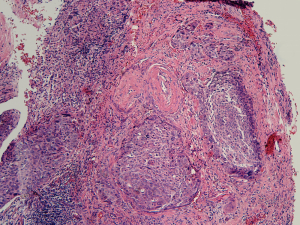Here I am discussing the histopathology of cervical cancer.
First, 85% of cervical cancer is “squamous cell carcinoma“, as the pathologist classifies them. For comparison here is a normal histology finding of the cervix.
This is the area of the cervix that is visible to the physician’s eye when he does a speculum examination and normally this is covered with cells called “squamous cells”. At times the lining of the cervical canal, which has adenoid glands, grows a bit out of the canal onto the outside surface of the cervix. Second, when this tissue turns cancerous, the pathologist diagnoses “adenocarcinoma“, which happens in about 12% of all cervical cancer cases.
Poorly differentiated cervical cancer
Third, the remaining 3% of cervical cancer is diagnosed by the pathologist as “adenosquamous cell carcinoma“. As the name says, they are a mixture of both malignant adenocarcinoma and malignant squamous cell carcinoma. These cancers are what the pathologist calls “poorly differentiated carcinoma“, meaning that they are fast growing tumors with a cancer survival rate that is very poor.
To complicate the picture, there are three grading types of squamous cell carcinoma: a well-differentiated, a moderately differentiated and a poorly differentiated one . Each of them has a different grade of malignancy with the most mature cell type having the best longterm survival and the most immature (poorly differentiated) type having the worst survival.
References
1. Cancer: Principles &Practice of Oncology.4th edition. Edited by Vincent T. DeVita, Jr. et al. Lippincott, Philadelphia,PA, 1993. Chapter on gynecological tumors.
2. Cancer: Principles&Practice of Oncology. 5th edition, volume 1. Edited by Vincent T. DeVita, Jr. et al. Lippincott-Raven Publ., Philadelphia,PA, 1997. Chapter on gynecological tumors.
3. WG Quint et al. J Pathol 2001 May;194(1):51-58.
4. A Duenas-Gonzalez et al. Am J Clin Oncol 2001 Apr;24(2):201-203.
5. BD Kavanagh et al. Am J Clin Oncol 2001 Apr;24(2):113-119.
6. K Nakanishi et al. Skeletal Radiol 2001 Mar;30(3):132-137.
7. M Follen et al. Cancer 2001 May 1;91(9):1758-1776.







